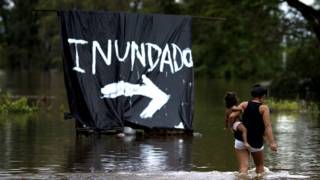 Image copyright AFP
Image copyright AFP
There are at least three strong reasons to believe that the phenomenon of the current El Niño will be as “big and powerful” as the considered worst history, 1997 and 1998.
related to the high temperatures of the ocean surface, the soaring temperatures in the northern hemisphere and that this year “El Niño shows no signs of retreat” Indicators, according the satellite images from NASA available.
For all this, the US space agency considers this 2015-2016 comparable to what many called the “ monstrous phenomenon ” 18 years ago.
“There is no doubt, are very similar. The events of 1982-1983 and 1997-1998 were the most impact in the previous century and in many ways it seems now we see a repeat “ told BBC News NASA expert William Patzert.
The research, analysis specialist weather events related to ocean circulation and air added this time “ is almost certain that the impact will be enormous .”
1. Oceans grown
Alturas much higher than the usual level in the Pacific Ocean are an indicator that there is a thick layer of hot water.
In both maps, generated by satellite, is see “classic pattern” phenomenon when almost or fully developed.
NASA called it “surprising” to the similarity in height anomalies recorded in December 1997 and 2015.
What you see on the graphs are the unusually high levels in the Pacific Ocean off the line of Ecuador.
The hot water and tibia that has accumulated in the area is what attracts the clouds and storms that have begun to occur in parts of Latin America, mainly in countries below the line of Ecuador.
Another consequence is the low level of rainfall in Southeast Asia, which contributed to the proliferation of large fires that have covered in smoke to the region a few weeks ago.
The heat in the Pacific region in 1997 was one of the weather phenomena that generated floods rarely seen before in countries like Bolivia, Paraguay, Peru, Argentina and Brazil in that year and the next.
The similarities in ocean temperature in both periods also it has remarkable similarities.
2. No decreases
El Niño is a natural phenomenon that occurs every two to seven years when the warm waters of the central Pacific Ocean expands eastward, closer to the shores of America.
usually reaches its most acute phase later this year but its effects are felt throughout the northern hemisphere spring and can last up to 12 months.
However, as NASA says The phenomenon this year is showing no signs of dissipating.
That’s “the signature of a great and powerful El Niño” , said NASA.
3. High temperatures
Patzert told BBC News that global warming currently facing the planet is a new factor influencing the nature and effects of El Niño.
“The planet is warmer now, that’s an important fact. A warmer planet generates more dangerous consequences, more extreme events, “the analyst NASA.
Numerous studies reported that climate change may exacerbate temperatures extreme periods like El Niño or La Niña.
Patzert said that the effects of El Niño are felt in the United States between January and March.
This year we are experiencing much higher temperatures than usual in the hemisphere north.
On Christmas Day in France, a historic record was just below that of 1997.
And even at the North Pole, where the December 30 is estimated the temperature has been above 0 degrees Celsius, when normal is -25 ° C.
In contrast, in Mexico, El Niño seems responsible for some unusual storms that have snowy north from the country. There is snow in parts of Sonora for the first time in 33 years.
In South and Central America, he says the researcher, the effects have already seen heavy flooding in recent weeks and will last at least three months.
Not all bad news, highlights Patzert.
The scientist said that despite the pronósiticos, there is more infrastructure and scientists to make more and better forecasts for the arrival of climate phenomenon progress.
However, it is likely that the consequences of El Niño will last through most of next year in the form of floods, epidemics or prolonged drought. . Primarily in South America
In one of its publications about NASA contudente reached a conclusion: “No matter where you live, feel the effects of El Nino”
No comments:
Post a Comment